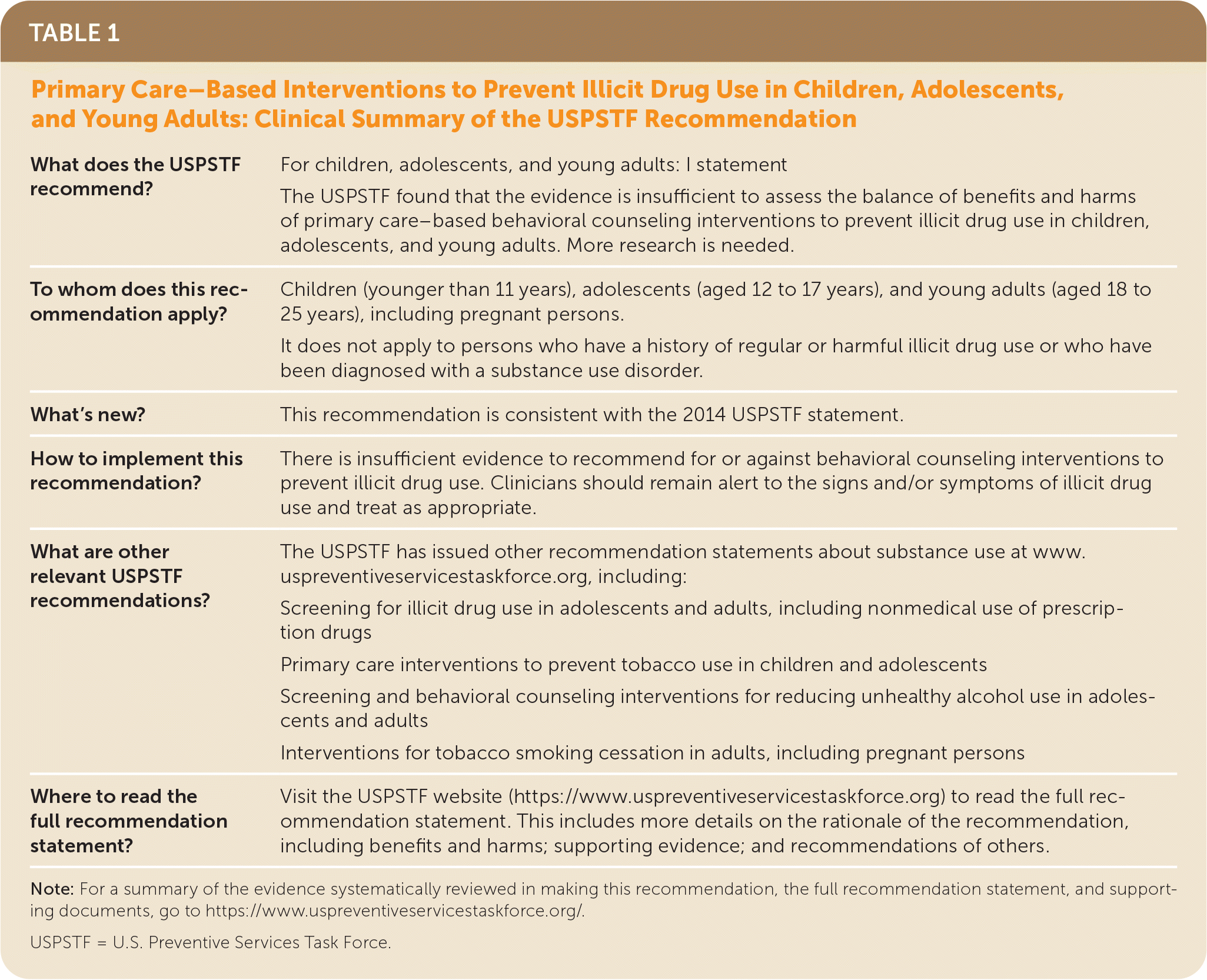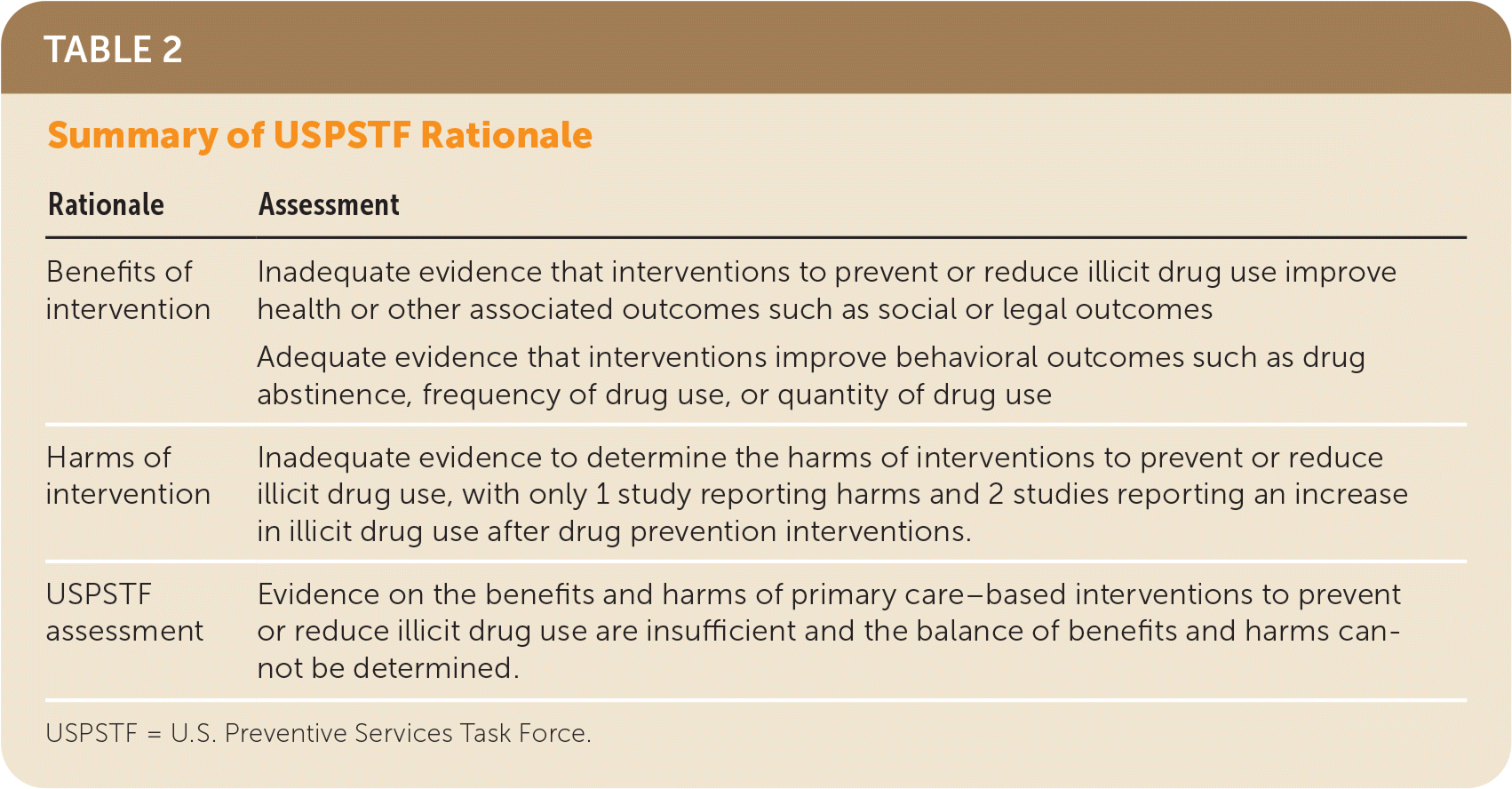
Am Fam Physician. 2020;102(8):online
Related Putting Prevention into Practice: Primary Care–Based Interventions to Prevent Illicit Drug Use in Children, Adolescents, and Young Adults
As published by the USPSTF.
Summary of Recommendation
The U.S. Preventive Services Task Force (USPSTF) concludes that the current evidence is insufficient to assess the balance of benefits and harms of primary care–based behavioral counseling interventions to prevent illicit drug use, including nonmedical use of prescription drugs, in children, adolescents, and young adults (Table 1). I statement.

| What does the USPSTF recommend? | For children, adolescents, and young adults: I statement The USPSTF found that the evidence is insufficient to assess the balance of benefits and harms of primary care–based behavioral counseling interventions to prevent illicit drug use in children, adolescents, and young adults. More research is needed. |
| To whom does this recommendation apply? | Children (younger than 11 years), adolescents (aged 12 to 17 years), and young adults (aged 18 to 25 years), including pregnant persons. It does not apply to persons who have a history of regular or harmful illicit drug use or who have been diagnosed with a substance use disorder. |
| What's new? | This recommendation is consistent with the 2014 USPSTF statement. |
| How to implement this recommendation? | There is insufficient evidence to recommend for or against behavioral counseling interventions to prevent illicit drug use. Clinicians should remain alert to the signs and/or symptoms of illicit drug use and treat as appropriate. |
| What are other relevant USPSTF recommendations? | The USPSTF has issued other recommendation statements about substance use at www.uspreventiveservicestaskforce.org, including: Screening for illicit drug use in adolescents and adults, including nonmedical use of prescription drugs Primary care interventions to prevent tobacco use in children and adolescents Screening and behavioral counseling interventions for reducing unhealthy alcohol use in adolescents and adults Interventions for tobacco smoking cessation in adults, including pregnant persons |
| Where to read the full recommendation statement? | Visit the USPSTF website (https://www.uspreventiveservicestaskforce.org) to read the full recommendation statement. This includes more details on the rationale of the recommendation, including benefits and harms; supporting evidence; and recommendations of others. |
Importance
In 2017, an estimated 7.9% of persons aged 12 to 17 years reported illicit drug use in the past month,1 and an estimated 50% of adolescents in the United States had used an illicit drug by the time they graduated from high school.2 Young adults aged 18 to 25 years have a higher rate of current illicit drug use, with an estimated 23.2% currently using illicit drugs. Similar to adolescents, the illicit drugs most commonly used by young adults are marijuana (20.8%) and prescription psychotherapeutics (4.6%).1 Illicit drug use is associated with many negative health, social, and economic consequences and is a significant contributor to 3 of the leading causes of death among young persons (aged 10 to 24 years): unintentional injuries including motor vehicle crashes, suicide, and homicide.3
USPSTF Assessment of Magnitude of Net Benefit
Because of limited and inadequate evidence, the USPSTF concludes that the benefits and harms of primary care–based interventions to prevent illicit drug use in children, adolescents, and young adults are uncertain and that the evidence is insufficient to assess the balance of benefits and harms. More research is needed.

| Rationale | Assessment |
|---|---|
| Benefits of intervention | Inadequate evidence that interventions to prevent or reduce illicit drug use improve health or other associated outcomes such as social or legal outcomes Adequate evidence that interventions improve behavioral outcomes such as drug abstinence, frequency of drug use, or quantity of drug use |
| Harms of intervention | Inadequate evidence to determine the harms of interventions to prevent or reduce illicit drug use, with only 1 study reporting harms and 2 studies reporting an increase in illicit drug use after drug prevention interventions. |
| USPSTF assessment | Evidence on the benefits and harms of primary care–based interventions to prevent or reduce illicit drug use are insufficient and the balance of benefits and harms cannot be determined. |
Practice Considerations
PATIENT POPULATION UNDER CONSIDERATION
This recommendation applies to children (11 years and younger), adolescents (aged 12–17 years), and young adults (aged 18–25 years), including pregnant persons. The purpose of this recommendation is to assess the evidence on interventions to prevent the initiation of illicit drug use and thus does not apply to persons who already have a history of regular or harmful illicit drug use. Children, adolescents, and young persons who are regular users of illicit drugs (at least once per week) or have been diagnosed with a substance use disorder are outside the scope of this recommendation.
Screening for illicit drug use in adults and adolescents (aged 12–17 years) is covered in a separate recommendation statement.5
DEFINITIONS OF ILLICIT DRUG USE, INCLUDING NONMEDICAL DRUG USE
The term “illicit drug use” is defined as the use of substances (not including alcohol or tobacco products) that are illegally obtained or involve nonmedical use of prescription medications; that is, drug use for reasons, for duration, in amounts, or with frequency other than prescribed, or use by persons other than the prescribed individual. Nonmedical drug use also includes the use of over-the-counter medications, such as cough suppressants. Other illicit drugs include household products such as glues, solvents, and gasoline. These substances are ingested, inhaled, injected, or administered using other methods to affect cognition, affect, or other mental processes; to “get high”; or for other nonmedical reasons.
INTERVENTIONS
The body of evidence to recommend specific interventions to prevent initiation of illicit drugs that can be provided or referred from the primary care setting is insufficient. Studied interventions include face-to-face or group counseling, print materials, interactive computer-based tools designed for patient use, and clinician training and quality improvement programs. Studies on these interventions provide inconsistent evidence on the net benefit to behavioral outcomes (drug abstinence or reduced frequency or quantity of illicit drug use) or health outcomes (morbidity, mortality, educational, or legal outcomes).
OTHER RELATED USPSTF RECOMMENDATIONS
The USPSTF has several recommendations on substance use–related services for young persons. The USPSTF is currently updating its recommendations on screening for illicit drug use in adults 18 years and older (B recommendation) and in adolescents aged 12 to 17 years (I statement).5 The USPSTF also has recommendations on screening and behavioral counseling interventions to reduce unhealthy alcohol use in adults 18 years and older (B recommendation) and adolescents aged 12 to 17 years (I statement).6 In addition, the USPSTF is currently updating its recommendations on education or brief counseling interventions to prevent initiation of tobacco use among school-aged children and adolescents (B recommendation) and interventions for the cessation of tobacco use among school-aged children and adolescents (I statement).7
SUGGESTIONS FOR PRACTICE REGARDING THE I STATEMENT
Potential Preventable Burden. Illicit drug use is associated with multiple negative health, social, and economic consequences. In 2011, the Drug Abuse Warning Network estimated that approximately 190,000 emergency department visits by persons aged 0 to 21 years involved illicit drug use (not including alcohol),8 and more than 79,000 of those visits were related to nonmedical use of opioids in persons aged 12 to 25 years.9 In 2015, drug overdose (both intentional and unintentional) accounted for 9.7 deaths per 100,000 persons aged 15 to 24 years.10
Frequent and heavy illicit drug use is associated with increased risk-taking behaviors while intoxicated, such as driving under the influence, unsafe sexual activity, and violence. In 2016, 73.6% of all deaths in young persons aged 10 to 24 years in the United States resulted from 3 causes: unintentional injuries, including motor vehicle crashes (41.1%); suicide (17.3%); and homicide (14.9%).3 Among the leading health risk behaviors, the use of alcohol and illicit drugs is the primary health risk behavior that contributes to these causes of death.11
Illicit drug use can also have harmful long-term consequences. Children and adolescents who initiate marijuana use before age 17 years are more likely to progress to other drug use and drug abuse/dependence as adults compared with those who initiate use after age 18 years.12 Studies have linked use of cannabis to poorer academic performance and lower educational attainment (i.e., dropping out of high school or not obtaining a college degree).13–15 Persistent illicit drug use starting in adolescence has been associated with negative psychosocial and neurocognitive effects, including increased anxiety and impaired abstract thinking, attention, learning, and psychomotor functioning.16,17
Potential Benefits. The USPSTF found inconsistent evidence on potential benefits associated with interventions. There was a small, statistically significant improvement in cannabis use specifically. However, other drug use outcomes (such as any illicit drug use and the number of times used in the last 3 months) failed to demonstrate statistically significant improvement. There was little evidence that interventions to prevent illicit drug use improve health outcomes such as mortality, educational attainment, or legal outcomes.
Current Practice. The USPSTF found little evidence on the frequency of use of behavioral counseling in primary care to prevent initiation of illicit drug use among nonusers or the escalation of use among persons who do not use illicit drugs regularly.
This recommendation statement was first published in JAMA. 2020;323(20):2060–2066.
The “Update of Previous USPSTF Recommendation,” “Supporting Evidence,” “Research Needs and Gaps,” and “Recommendations of Others” sections of this recommendation statement are available at https://www.uspreventiveservicestaskforce.org/uspstf/recommendation/drug-use-illicit-primary-care-interventions-for-children-and-adolescents.
The USPSTF recommendations are independent of the U.S. government. They do not represent the views of the Agency for Healthcare Research and Quality, the U.S. Department of Health and Human Services, or the U.S. Public Health Service.
